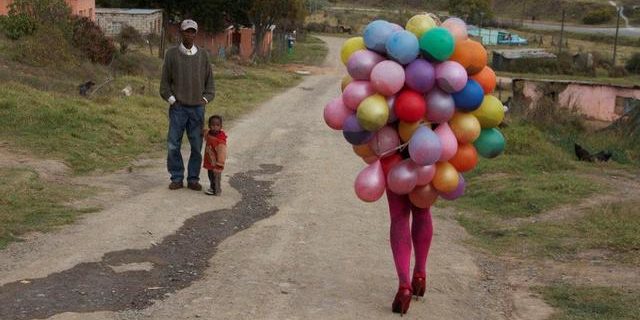Imagine a pinup calendar that revisits history through color, and woven in a manner that depicts your past and future in an amusing way. Confused?
Well that is what the future looks like for South African performing artist Athi-Patra Ruga, known for his flamboyant performances and tapestries that challenge social norms.
Growing up in the Eastern Cape Province of South Africa, Ruga knew at a young age he would become an artist, taking lessons, after school, at Belgravia Art Centre. He then received a scholarship to the Gordon Flack Davidson Academy of Design in Johannesburg.
“I had always known my body would be a site for telling stories. I feel the drive to tell stories, [I] overcame my fears – about it never been done before,” he says.
When he cut his teeth in art, he dabbled in fashion designing, incorporating fashion and art into one.
Loading...
“Fashion has the power to dictate our movements physically and socially, to [a] great consequence. I have never seen it as a huge leap as both those mediums are concerned with the body,” says Ruga.
His current body of work is Queens in Exile, addressing issues of belonging and identity. However, it is his piece on the queens of Azania that put him on the cultural map.
“I feel it sparked something in the audience that [binds] our generation together. Witnessing the betrayal to the constitution I was raised with and also rainbowism, a utopian construct, played out in the country that is economically the most unequal in the world,” says Ruga.
Ruga was the Standard Bank Young Artist of the Year in 2015 and has done work for luxury fashion house Louis Vuitton. Believing the world is alive with possibilities, he held on to the hope he would one day travel the world.
“I had always dreamt of going to the south of France and now for the past five years, my husband and I have been going to Toulon for the Hyères festival,” says Ruga.
The Eastern Cape has produced some of South Africa’s great political leaders, from Nelson Mandela to Steve Biko, so it is little wonder Ruga’s work has strong historical references.
“History has the ability to arm us as a dispossessed youth, with knowledge that our forefathers went through the same things we are going through and we need that knowledge to arm us to find sophisticated ways of mobilizing for economic and cultural currency,” says Ruga.
He desensitizes “uncomfortable” topics using vibrant colors. His work is represented by the WHATIFTHEWORLD gallery in Cape Town, and in Paris, by InSitu Fabienne Leclerc.
There is also a lot of story-telling in his work which comes from his father being a journalist.

“I come from a family of people who enjoyed telling stories and I gravitate to that tradition of storytelling in my art,” says Ruga.
His industry is faced with numerous challenges, but Ruga chose early on in his career to not focus on the negative.
“I’m honestly not concerned with focusing on challenges, that’s not how I got here. It is the attitude that defines how I will overcome that is ultimate. Our education system is something we all need to face and improve as that leads one to art and in return empathy for others,” he says.
Ruga encourages upcoming artists to venture into different spheres such as photography, art and designing as they are lucrative.
He says there are more than enough role models across the continent one could look up to such as Nicholas Hlobo, a South African contemporary artist who creates sculptures and explores ethnicity, masculinity, and sexual identity. He too looks up to him.
Despite the global exposure and success at home, Ruga is convinced the best is yet to come.
“I always feel my big break hasn’t happened yet,” he says. That will be a story for another time.
Loading...
